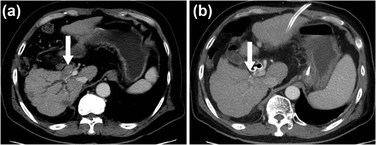Photodynamic therapy for bile duct invasion of hepatocellular carcinoma
Abstract
The prognosis of patients with obstructive jaundice caused by hepatocellular carcinoma (HCC) is dismal, because effective biliary drainage is difficult due to frequent malfunction of the drainage tube caused by hemobilia and/or tumor emboli. Photodynamic therapy (PDT) improves biliary patency and prolongs survival in hilar cholangiocarcinoma. The aim of this study was to assess the safety and efficacy of PDT in unresectable HCC with bile duct invasion. Between January 2009 and September 2010, eleven patients with bile duct invasion of unresectable HCC were enrolled at Samsung Medical Center. PDT was performed with 180 J cm−1 light activation 48 hours after administration of the photosensitizer at a dose of 2 mg kg−1 body weight. Biliary drainages were performed in all patients. The safety and efficacy of PDT were prospectively evaluated. Eleven patients had successful PDT and biliary drainage. Jaundice improved in seven out of ten patients who had jaundice before PDT. Hemobilia, which had developed in six cases, was controlled by PDT. There were no complications from the photosensitizer. There was no 30-day mortality, and the mean survival was 140.5 days. PDT controlled hemobilia associated with bile duct invasion of HCC and could be an effective treatment option in these patients.


 Please wait while we load your content...
Please wait while we load your content...